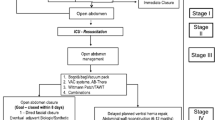Abstract
Background
Abdominal Vacuum-Assisted Closure (V.A.C.) systems for treatment of open abdomens have been predominantly used for trauma patients with a high primary fascial closure rate. Use of the V.A.C. technique in abdominal sepsis is less well established.
Methods
All patients with abdominal sepsis and treatment with the abdominal V.A.C. system between 2004 and 2007 were prospectively assessed. End points were fascial closure, V.A.C.-related morbidity, and quality of life score (SF-36) at follow-up.
Results
Thirty patients with abdominal sepsis were included in the study. Primary fascial closure was feasible in 10, partial closure in 4, and no closure in 16 patients. Median number of V.A.C. changes was 3 (range, 1–10). Nine patients died. V.A.C.-related morbidity was as follows: two fistulas, three fascial edge necroses, one skin blister, and four prolapses of small bowel between the fascia and foam. Univariate analysis showed no variables influencing primary closure rate or V.A.C.-related morbidity. Mortality was significantly influenced by age (P < 0.001), respiratory failure (P = 0.01), and pneumonia (P = 0.03). At follow-up, V.A.C. patients scored lower in the physical health scores and similar in the mental health scores compared with the normal population.
Conclusions
Treatment of the open abdomen in patients with abdominal sepsis with the abdominal V.A.C. system is safe with good long-term quality of life. Primary closure rate in these patients is substantially lower than in trauma patients. Stepwise closure of the fascia during V.A.C. changes should be attempted to avoid additional lateral retraction of fascial edges. V.A.C.-related complications may be avoided with careful surgical technique.

Similar content being viewed by others
References
Tsuei BJ, Skinner JC, Bernard AC et al (2004) The open peritoneal cavity: etiology correlates with the likelihood of fascial closure. Am Surg 70:652–656
Oetting P, Rau B, Schlag PM (2006) Abdominal vacuum device with open abdomen. Chirurg 77:586–593
Adkins AL, Robbins J, Villalba M et al (2004) Open management of intra-abdominal sepsis. Am Surg 70:137–140
Miller PR, Thompson JT, Faler BJ et al (2002) Late fascial closure in lieu of ventral hernia: the next step in open abdomen management. J Trauma 53:843–849
Fernandez L, Norwood S, Roettger R et al (1996) Temporary intravenous bag silo closure in severe abdominal trauma. J Trauma 40:258–260
Cothren CC, Moore EE, Johnson JL et al (2006) One hundred percent fascial approximation with sequential abdominal closure of the open abdomen. Am J Surg 192:238–242
Navsaria PH, Bunting M, Omoshoro-Jones J et al (2003) Temporary closure of abdominal wounds by the modified sandwich-vacuum pack technique. Br J Surg 90:718–722
Nagy KK, Fildes JJ, Mahr C et al (1996) Experience with three prosthetic materials in temporary abdominal wall closure. Am Surg 62:331–335
Stone PA, Hass SM, Flaherty SK et al (2004) Vacuum-assisted fascial closure for patients with abdominal trauma. J Trauma 57:1082–1086
Barker DE, Kaufman HJ, Smith LA et al (2000) Vacuum pack technique of temporary abdominal closure: a 7-year experience with 112 patients. J Trauma 48:201–207
Labler L, Zwingmann J, Mayer D et al (2005) V.A.C. abdominal dressing system. Eur J Trauma 5:488–494
Miller PR, Meredith JW, Johnson JC et al (2004) Prospective evaluation of vacuum-assisted fascial closure after open abdomen. Ann Surg 239:608–616
Cipolla J, Stawicki SP, Hoff WS et al (2005) A proposed algorithm for managing the open abdomen. Am Surg 71:202–207
Rao M, Burke D, Finan PJ et al (2007) The use of vacuum-assisted closure of abdominal wounds: a word of caution. Colorectal Dis 9:266–268
Perez D, Wildi S, Demartines N et al (2007) Prospective evaluation of vacuum-assisted closure in abdominal compartment syndrome and severe abdominal sepsis. J Am Coll Surg 205:586–592
Smith LA, Barker DE, Chase CW et al (1997) Vacuum pack technique of temporary abdominal closure: a four-year experience. Am Surg 63:1102–1108
Olejnik J, Sedlak I, Brychta I et al (2007) Vacuum supported laparostomy: an effective treatment of intra-abdominal infection. Bratisl Lek Listy 108:320–323
Calandra T, Cohne J (2005) The international sepsis forum consensus conference on definitions of infection in the intensive care unit. Crit Care Med 33:1538–1548
Ivancevic N, Radenkovic D, Bumbasirevic V et al (2008) Procalcitonin in preoperative diagnosis of abdominal sepsis. Langenbecks Arch Surg 393:3397–3403 Epub 2007 Oct 30
Maier S, Traeger T, Westerholt A et al (2005) Special aspects of abdominal sepsis. Chirurg 76:829–836
Wacha H, Linder MM, Feldmann U et al (1987) Mannheim peritonitis index–prediction of risk of death from peritonitis: construction of a statistical and validation of an empirically based index. Theo Surg 1:169–177
Linder MM, Wacha H, Feldmann U et al (1987) The Mannheim peritonitis index. An instrument for the intraoperative prognosis of peritonitis. Chirurg 58:84–92
Bullinger M (1995) German translation and psychometric testing of the SF-36 health survey: preliminary results from the IQOLA project. Soc Sci Med 41:1359–1366
Barker DE, Green JM, Maxwell RA et al (2007) Experience with vacuum-pack temporary abdominal wound closure in 258 trauma patients and general and vascular surgical patients. J A. Coll Surg 204:784–793
Suliburk JW, Ware DN, Balogh Z et al (2003) Vacuum-assisted wound closure achieves early fascial closure of open abdomens after severe trauma. J Trauma 55:1155–1160
Petersson U, Acosta S, Bjoerck M (2007) Vacuum-assisted wound closure and mesh-mediated fascial traction – a novel technique for late closure of the open abdomen. World J Surg 31:2133–2137
Stonerock CE, Bynoe RP, Yost MJ et al (2003) Use of a vacuum-assisted device to facilitate abdominal closure. Am Surg 69:1030–1034
Starr-Marshall K (2007) Vacuum-assisted closure of abdominal wounds and entero-cutaneous fistulae: the St Marks experience. Colorectal Dis 9:573
Acknowledgements
The authors thank Dr. C. Baughman and Dr. J. Chisholm for help in preparation of the manuscript in English.
Author information
Authors and Affiliations
Corresponding author
Rights and permissions
About this article
Cite this article
Wondberg, D., Larusson, H.J., Metzger, U. et al. Treatment of the Open Abdomen with the Commercially Available Vacuum-Assisted Closure System in Patients with Abdominal Sepsis. World J Surg 32, 2724–2729 (2008). https://doi.org/10.1007/s00268-008-9762-y
Published:
Issue Date:
DOI: https://doi.org/10.1007/s00268-008-9762-y




